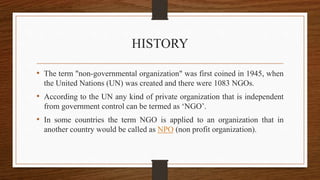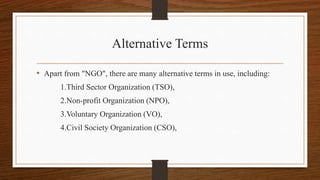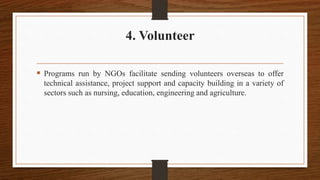Ngo
- 2. INTRODUCTION • A non-governmental organization (NGO) is an organization that is neither a part of a government nor a conventional for-profit business. • NGOs may be funded by governments, foundations, schools, businesses or private people. • Some may have charitable status, while others may be registered for tax exemption based on recognition of social purposes. Others may be fronts for political, religious, or other interests.
- 3. HISTORY • The term "non-governmental organization" was first coined in 1945, when the United Nations (UN) was created and there were 1083 NGOs. • According to the UN any kind of private organization that is independent from government control can be termed as ‘NGO’. • In some countries the term NGO is applied to an organization that in another country would be called as NPO (non profit organization).
- 4. Contd., • International NGOs were important in the anti-slavery movement and the movement for women's suffrage. • Based on Societies Registration Act (SRA) NGO was approved in 1860. • India is estimated to had around 2 million NGOs in 2014.
- 5. Alternative Terms • Apart from "NGO", there are many alternative terms in use, including: 1.Third Sector Organization (TSO), 2.Non-profit Organization (NPO), 3.Voluntary Organization (VO), 4.Civil Society Organization (CSO),
- 6. Contd., 5.Grassroots Organization (GO), 6.Social Movement Organization (SMO), 7.Private Voluntary Organization (PVO) and 8.Self-help Organization (SHO).
- 7. ACTIVITIES • It includes Human rights, Environmental, Improving health, or development work. • An NGO's level of operation indicates the scale at which an organization works, such as local, regional, national, or international.
- 10. 1.First tier :- It is main source of funding. It includes government bodies, international agencies or individuals etc. 2.Second tier: – Main function of this tier is to distribute the funds provided by first tier. 3.Third tier :– This tier includes NGOs. Its function is to link with fund applicant. 4.Fourth tier :– This tier represents the recipient of funds provided by NGOs.
- 11. By Area of Interest • Research • Aged and elderly • Animal Husbandry, Dairying & Fisheries • Animal Welfare • Art & Culture • Biotechnology • Children
- 12. By Organization • Ministry • Private Ltd Company • Foundation • Bilateral Agency • Government • Public Sector Unit • Multilateral Agency
- 13. NGO REGISTRATION 1. Non Profit Company under Section 8 of Indian Companies Act 2013 2. Indian Trust Act, 1882 NGO registration is a initial stage to work and move towards Social Service Sector. After registration of NGO how to keep its status in active condition and how to achieve the targets to complete the Objects for which NGOs are formed.
- 14. Types of NGO A. NGO types By orientation : 1. Professional association A group of people in a learned occupation who are entrusted with maintaining control or oversight of the legitimate practice of the occupation To safeguard the public interest It also represent the interest of the professional practitioners
- 15. 2. Empowering orientation The aim is to help poor people develop a clearer understanding of the social, political and economic factors affecting their lives. To strengthen their awareness of their own potential power to control their lives.
- 16. 3. Charitable Orientation It includes NGOs with activities directed toward meeting the needs of the poor E.g.: distribution of food, clothing or medicine; provision of housing, transport, schools etc. Such NGOs may also undertake relief activities during a natural or man- made disaster.
- 17. 4.Participatory Orientation : • It is characterized by self-help projects where local people are involved particularly in the implementation of a project by contributing Cash, tools, land, materials, labour etc. 5. Service Orientation : • It includes NGOs with activities such as the provision of health, family planning or education services
- 18. B.NGO Types by level of operation: 1. Community-based Organizations (CBOs) : Created by people’s own interest . These can include sports clubs, women's organizations, neighbourhood organizations, religious or educational organizations. Main objective of these organizations is to help urban people and aware them to understand their rights and provide required services.
- 19. 2. Citywide Organizations : They include various organizations related to sports, education and association of community based organizations. For example chambers of commerce and industry, coalition of business, educational group.
- 20. 3. National NGOs : These are professional organizations. Function of these NGOs is to support local NGOs It include organizations such as the Red Cross, YMCAs/YWCAs (Young Men's Christian Association ) /(Young Women's Christian Association) , professional organizations etc.
- 21. 4.International NGOs : Main function of this NGOs is funding to local NGOs, implementing various projects. It range from secular agencies such as REDDA BARNA and Save the Children organizations, CARE, UNDP, and UNICEF, Ford and Rockefeller Foundations to religiously motivated groups.
- 22. Approaches under NGO 1. Grassroots development : It targets disadvantaged groups through small, locally based projects. These projects usually involve training and education programs to transfer skills and build the capacity and confidence of local organisations and communities. This approach at its most successful allows the benefits of a project to continue beyond the duration of the project itself.
- 23. 2.Humanitarian/Emergency Relief • It focuses on relief in times of disaster such as earthquakes, floods and cyclones. • NGOs in this area aim to gain access to disaster zones as quickly as possible to provide emergency health services and food aid.
- 24. 3. Advocacy It aims to draw public attention to an issue and influence government policy either on behalf of, or alongside, a particular community interest group. It can be approached through high level policy dialogues, lobbying, or through grassroots and community campaigning. The level of involvement of affected communities differ with each organisation.
- 25. 4. Volunteer Programs run by NGOs facilitate sending volunteers overseas to offer technical assistance, project support and capacity building in a variety of sectors such as nursing, education, engineering and agriculture.
- 26. TOP 10 NGOs IN INDIA 1. Help age India 2. Barefoot college 3. Aravind Eyecare System 4. Smile foundation 5. Goonj 6. Planet read 7. Give India
- 27. Contd., 8. Gram Vikas 9. Pratham 10. Udaan
- 28. NGO’s in Tamil Nadu – North • GAIA International Organization (GIO); Thiruvanmiur, Chennai. • SOHES; Kanchipuram. • MSSRF; Poombuhar. • Fisheries Professional Organization (FPO); Chennai.
- 29. NGO’s in Tamil Nadu - South • Village Resource Centre of MSSRF; Nagarcoil, Kanyakumari. • Village Resource Centre of MSSRF; Ramanathapuram. • OMCAR foundation; Pattukottai. • Chevallar Roshe Society (CRS), Derose centre; Thoothukkudi.
- 30. Thank u






























